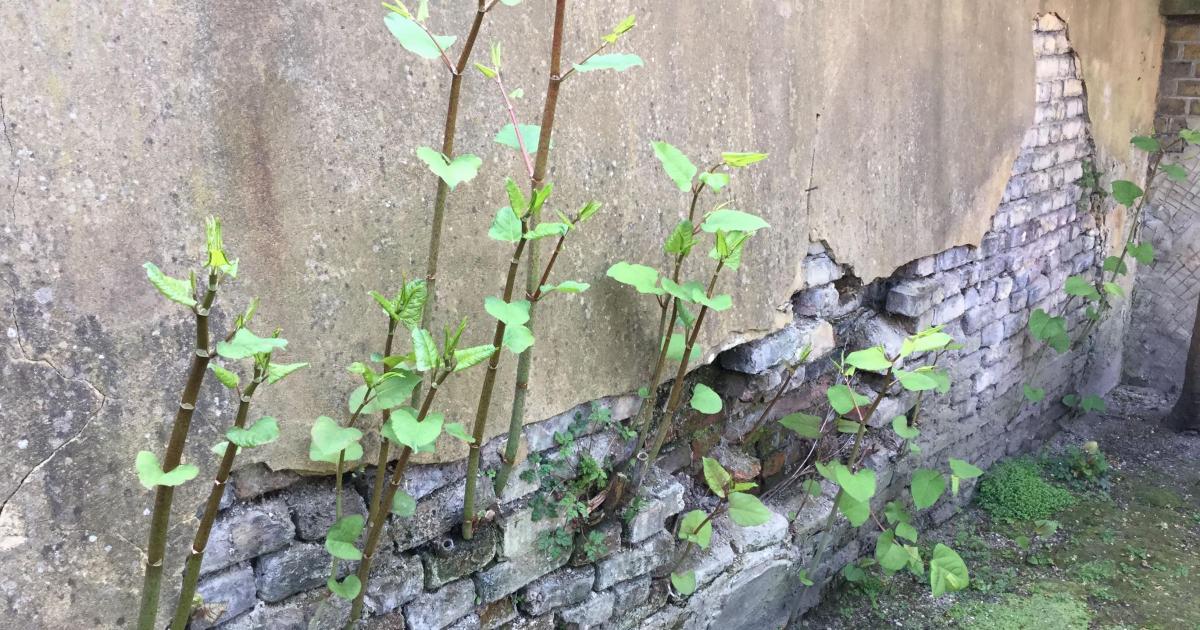The worst affected locations include Kingswood and Lydney.
Yet despite widespread awareness – with 77 per cent of UK adults having heard of knotweed according a YouGov survey – myths and misinformation have also taken hold, causing additional worry for homeowners and buyers.
To separate fact from fiction, invasive plant experts Environet tackle the ten most common misconceptions about knotweed – and the truth behind them.
1. You can kill knotweed with bleach or petrol
Household chemicals, petrol or diesel, or treatments purchased from a garden centre or DIY store will rarely be strong enough to kill knotweed’s underground root system. The plant might appear to be dead, but it’s more likely induced into dormancy which means the rhizome remains alive and ready to regrow.
2. Covering knotweed to block sunlight will kill it
Every plant needs sunlight to survive, but if covered, knotweed rhizome will usually grow laterally in search of sunlight, emerging at the side of a tarpaulin, patio or driveway. Even if it doesn’t appear, the underground parts of the plant are likely to remain alive for many years.
3. Knotweed can push through concrete
No, it can’t push directly through concrete. But it can and does exploit weaknesses such as cracks or joins between concrete slabs. It can also push up through patios and asphalt paths and driveways.
4. It’s illegal to have Japanese knotweed on your land
It’s not illegal and it’s not a notifiable weed, so you don’t have to tell the authorities either. But if you allow it to spread onto a neighbour’s property, or if you’re selling your property and fail to disclose it to a buyer, you leave yourself vulnerable to a legal case.
5. You can’t get a mortgage if you have knotweed
Today, most mortgage lenders will provide mortgages on affected properties – but only with a professional management plan in place from a reputable firm, accompanied by an insurance-backed guarantee, so they are reassured it’s being properly dealt with.
6. If knotweed has been treated, you don’t need to declare it when you sell
Lots of people are caught out by this. Even if knotweed on your property has been professionally treated and there is no evidence of regrowth, you still need to declare it on the Law Society’s TA6 form when you sell. Failure to do so could result in you being sued for misrepresentation, making you liable not just for the cost of any additional treatment but also any resulting diminution in the value of the property.
7. Knotweed can only be treated during summer
It’s true that herbicide treatment can only take place during the growing season, typically between May and September, as the leaves absorb the chemicals and draw them down into the roots. However, knotweed can be excavated from the ground at any time of year, including winter, which is a much more immediate and effective method of dealing with it.
8. If it’s next door, you can force your neighbour to act
The last thing anyone wants to see is a towering forest of knotweed over the garden fence, but legally your neighbour has every right to allow knotweed to grow on their property. Their only obligation to you is to prevent it from spreading across the boundary – but until it does, there’s nothing you can do apart from politely ask them to deal with it.
9. You can put knotweed on the compost heap
With the exception of brown, brittle canes or fallen leaves, unless you’re a composting guru this is definitely a bad idea. Knotweed can regrow from a piece of rhizome the size of a fingernail, weighing just 5g, and its chances of success will only be helped along by the warm and humid conditions of a compost heap or bin. Get it wrong, and you’ll have a brand new infestation by next spring.
10. Knotweed spreads by seed
This is true in its native Asia, but all the Japanese knotweed plants in the UK are female, so ovules can’t be fertilised and no viable seeds are produced. Knotweed spread is via vegetative reproduction, meaning a shoot grows from the rhizome of the parent plant and establishes itself as an independent plant.
Environet Director Emily Grant said, “There are plenty of unhelpful myths about Japanese knotweed that only add to homeowners’ anxiety. It is the most problematic plant in the country, but it can be managed and, with the right treatment plan in place, eradicated for good.
” As we head through autumn, knotweed will start to die back and become harder to spot, but this can be the ideal time to tackle it, ensuring the garden is back to full use during the spring and summer months.”
